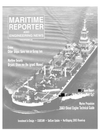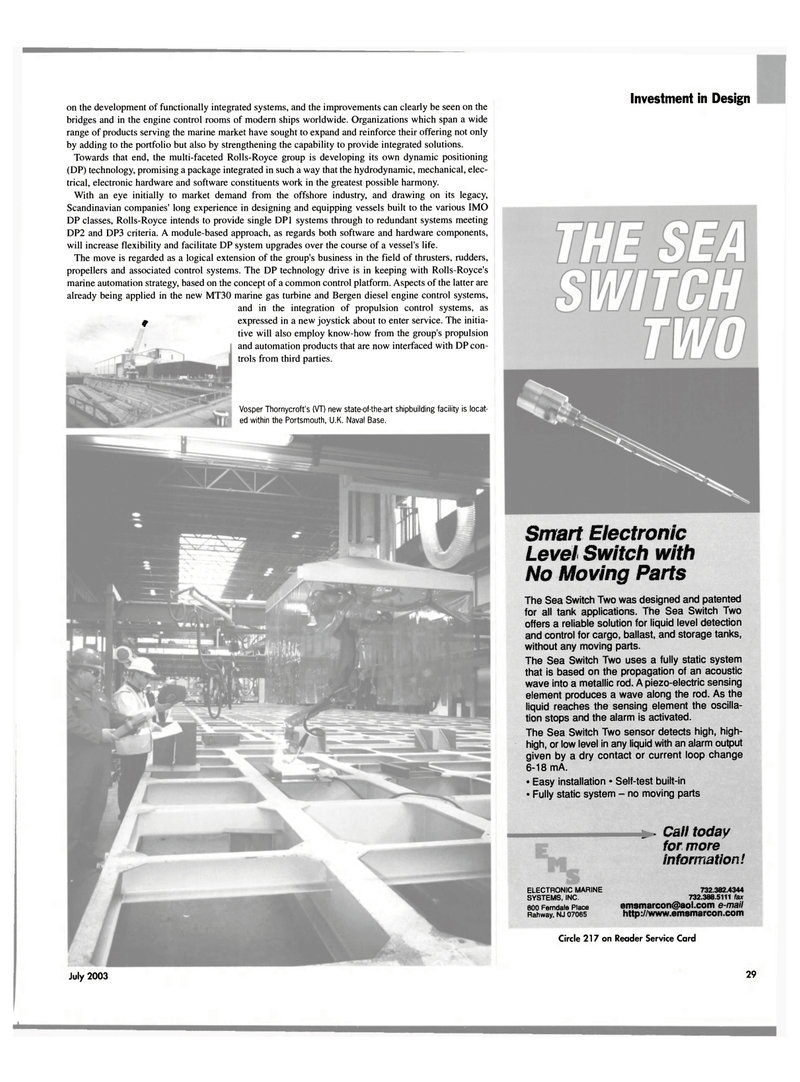
Page 27: of Maritime Reporter Magazine (July 2003)
Read this page in Pdf, Flash or Html5 edition of July 2003 Maritime Reporter Magazine
on the development of functionally integrated systems, and the improvements can clearly be seen on the bridges and in the engine control rooms of modern ships worldwide. Organizations which span a wide range of products serving the marine market have sought to expand and reinforce their offering not only by adding to the portfolio but also by strengthening the capability to provide integrated solutions.
Towards that end, the multi-faceted Rolls-Royce group is developing its own dynamic positioning (DP) technology, promising a package integrated in such a way that the hydrodynamic, mechanical, elec- trical, electronic hardware and software constituents work in the greatest possible harmony.
With an eye initially to market demand from the offshore industry, and drawing on its legacy,
Scandinavian companies' long experience in designing and equipping vessels built to the various IMO
DP classes, Rolls-Royce intends to provide single DPI systems through to redundant systems meeting
DP2 and DP3 criteria. A module-based approach, as regards both software and hardware components, will increase flexibility and facilitate DP system upgrades over the course of a vessel's life.
The move is regarded as a logical extension of the group's business in the field of thrusters, rudders, propellers and associated control systems. The DP technology drive is in keeping with Rolls-Royce's marine automation strategy, based on the concept of a common control platform. Aspects of the latter are already being applied in the new MT30 marine gas turbine and Bergen diesel engine control systems, and in the integration of propulsion control systems, as ^ expressed in a new joystick about to enter service. The initia- tive will also employ know-how from the group's propulsion and automation products that are now interfaced with DP con- trols from third parties.
Vosper Thornycroft's (VT) new state-of-the-art shipbuilding facility is locat- ed within the Portsmouth, U.K. Naval Base.
Investment in Design
Smart Electronic
Level Switch with
No Moving Parts
The Sea Switch Two was designed and patented for all tank applications. The Sea Switch Two offers a reliable solution for liquid level detection and control for cargo, ballast, and storage tanks, without any moving parts.
The Sea Switch Two uses a fully static system that is based on the propagation of an acoustic wave into a metallic rod. A piezo-electric sensing element produces a wave along the rod. As the liquid reaches the sensing element the oscilla- tion stops and the alarm is activated.
The Sea Switch Two sensor detects high, high- high, or low level in any liquid with an alarm output given by a dry contact or current loop change 6-18 mA. * Easy installation * Self-test built-in • Fully static system - no moving parts
ELECTRONIC MARINE
SYSTEMS, INC. 800 Ferndale Place
Rahway, NJ 07065 ^ Call today for more information! 732.382.4344 732.388.5111 fax [email protected] e-mail http://www.emsmarcon.com
Circle 217 on Reader Service Card
July, 2003 29

 26
26

 28
28
